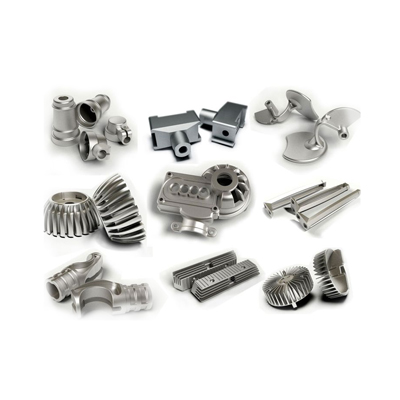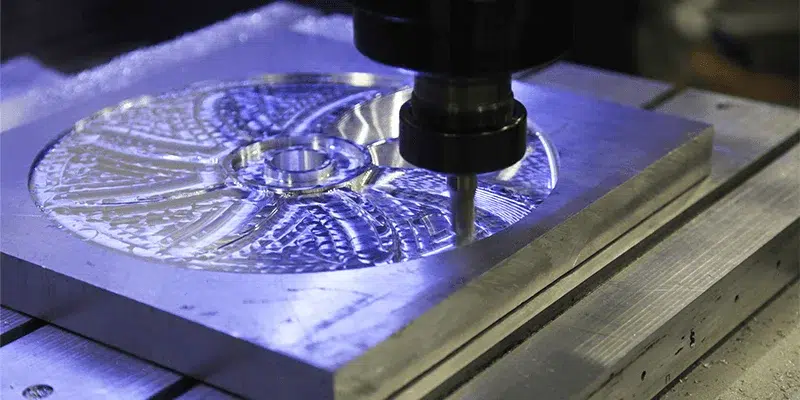Checking out the Benefits of Making Use Of Aluminum Castings in Modern Production
Aluminum castings have ended up being significantly appropriate in modern-day manufacturing as a result of their one-of-a-kind homes. The lightweight nature of aluminum enables a lot more complex layouts, specifically helpful in markets such as auto and aerospace. Its rust resistance expands item life-span, while cost-effectiveness boosts manufacturing performance. These benefits invite a closer assessment of aluminum's duty in various applications and its effect on design adaptability and sustainability in manufacturing processes.
Light-weight Characteristics and Their Effect On Design
The light-weight residential properties of aluminum castings greatly affect modern style methods across various industries. Developers and engineers often focus on weight reduction in their jobs to enhance performance and efficiency. This particular enables the production of intricate shapes and styles that would certainly be testing with larger products. In industries such as automotive and aerospace, where every gram counts, aluminum castings add to sustain performance and minimized emissions. Furthermore, the simplicity of making processes like die casting allows the manufacturing of complex geometries, bring about ingenious product styles. The capacity to balance strength and weight makes aluminum an enticing option for suppliers wanting to optimize product performance while reducing manufacturing prices. As sectors proceed to progress, the adoption of aluminum castings is most likely to broaden, promoting brand-new opportunities for layout creativity and design developments. Overall, the light-weight nature of aluminum is an essential element in shaping contemporary production practices.

Superior Deterioration Resistance for Durability
Several materials endure from degradation over time, aluminum castings stand out for their exceptional deterioration resistance, significantly boosting the long life of products. This resistance is mostly connected to the natural formation of a protective oxide layer on the aluminum surface, which inhibits more oxidation and protects against rusting. Unlike steel or iron, aluminum does not corrode quickly when subjected to wetness or numerous chemicals, making it an optimal selection for applications in rough environments.
Additionally, aluminum castings preserve architectural honesty over prolonged periods, reducing the need for frequent replacements. This dependability is crucial in fields such as automobile, aerospace, and aquatic, where element failure might cause significant safety concerns. By selecting aluminum castings, producers can assure that their items not just endure the examination of time yet additionally perform continually under difficult problems, eventually profiting both producers and end-users via boosted durability and fewer maintenance requirements.
Cost-Effectiveness in Production
Cost-effectiveness in aluminum casting production is driven by numerous vital variables. Minimized product waste contributes to reduce production costs, while rapid manufacturing times enhance overall efficiency. These aspects collectively position aluminum castings as a practical option for suppliers looking for to maximize their procedures.
Lowered Material Waste
Minimizing material waste in aluminum casting not only enhances sustainability but also markedly decreases manufacturing costs. Reliable use basic materials is important in contemporary production, where reducing waste can result in substantial savings. Aluminum casting processes enable for complex layouts with precise specifications, which helps to optimize product use and minimize excess. Methods such as near-net form casting additionally limit the amount of scrap generated throughout production. Additionally, the recyclability of aluminum adds to a decrease in waste, as leftover products can be thawed and reused in future applications. By adopting aluminum casting approaches, producers can achieve not just an extra eco-friendly operation but also a streamlined production process that makes best use of resource efficiency and decreases total material prices.
Lower Production Expenses

Fast Manufacturing Times
While lots of factors add to the general efficiency of manufacturing processes, rapid manufacturing times stand out as a significant advantage of aluminum casting. This method permits the fast development of components, substantially decreasing preparations. The ability to produce complex forms with high precision indicates that suppliers can quickly respond to market needs and scale manufacturing as needed. Additionally, aluminum's desirable thermal residential properties make it possible for faster cooling rates, additionally expediting the total casting procedure. Subsequently, shorter production cycles lead to improved inventory turnover and minimized functional costs. By decreasing hold-ups and enhancing throughput, aluminum casting supports a more dexterous manufacturing atmosphere, eventually contributing to raised competitiveness in the marketplace.
Layout Flexibility and Complicated Geometries
Aluminum castings use exceptional design versatility, allowing the development of complex geometries that would certainly be challenging with various other materials. This capacity enables producers to create lightweight architectural options that boost general performance and efficiency. In addition, the fast prototyping capacity of aluminum castings increases the advancement process, assisting in technology in design.
Intricate Design Capabilities

Light-weight Structural Solutions
Makers increasingly leverage aluminum castings to supply light-weight architectural remedies that do not jeopardize on stamina or resilience. The inherent residential properties of aluminum, including its low thickness and high strength-to-weight ratio, make it an excellent option for applications where weight reduction is essential. This lightweight particular facilitates layout flexibility, permitting designers to produce complicated geometries that traditional materials might not suit. Furthermore, aluminum castings can be customized to specific efficiency demands, enhancing capability without including too much weight. This flexibility makes it possible for the production of intricate elements for various industries, such as aerospace and auto, where efficiency and performance are vital. On the whole, aluminum castings play a vital role beforehand modern production with ingenious structural layouts.
Rapid Prototyping Potential
Quick prototyping has actually emerged you can find out more as a game-changer in contemporary production, particularly when it comes to make flexibility and the capacity to create complicated geometries. Aluminum castings promote this technology, allowing engineers to produce intricate designs that would certainly be tough or impossible with conventional methods. The lightweight nature of aluminum improves the ease of manipulation throughout the prototyping phase, allowing quick versions and modifications. The material's exceptional thermal conductivity and deterioration resistance add to the longevity of prototypes, making them appropriate for screening in real-world conditions. Consequently, manufacturers can accelerate item growth cycles, reduce prices, and improve development. Ultimately, the integration of aluminum castings right into reference quick prototyping procedures supports the creation of sophisticated, high-performance elements tailored to details applications.
Improved Thermal and Electric Conductivity
While aluminum castings are renowned for their light-weight properties, their enhanced thermal and electrical conductivity also plays a necessary duty in modern manufacturing. This characteristic makes aluminum an ideal selection for applications calling for effective warm dissipation and electric efficiency. As an example, elements in electronics gain from aluminum's capacity to successfully move warmth, consequently reducing the threat of overheating and extending gadget lifespan. In automobile and aerospace markets, aluminum castings add to improved thermal monitoring systems, promoting power efficiency.
The high electric conductivity of aluminum permits for its prevalent usage in electric elements, such as ports and bus bars. This attribute not just lowers power loss throughout transmission yet additionally enhances general performance. The mix of these properties positions aluminum castings as a preferred material in various applications, driving development and effectiveness in making procedures across various fields.
Sustainability and Ecological Advantages
Aluminum castings offer significant sustainability and ecological advantages, aligning with the growing focus on green production practices. Among the primary advantages of aluminum is its recyclability; up to 95% of aluminum can be reused without shedding quality. This process takes in just a fraction of the energy needed for main production, substantially decreasing greenhouse gas exhausts.
Additionally, aluminum is lightweight, which adds to energy performance in transport and product usage. Its sturdiness and resistance to rust extend the life expectancy of items, decreasing waste and the need for frequent substitutes. In addition, using aluminum castings can cause more effective manufacturing procedures, as they frequently require less energy and product contrasted to traditional methods.
Applications Throughout Different Industries
As sectors significantly look for functional materials for innovative applications, aluminum castings have arised as a prominent option across different sectors. In the auto market, lightweight aluminum castings add to enhanced fuel effectiveness and efficiency, while in aerospace, they give strength without jeopardizing weight, vital for airplane layout. The customer electronic devices industry benefits from aluminum's exceptional thermal conductivity, making it ideal for heat sinks and enclosures. Additionally, the building and construction sector utilizes aluminum castings for home window structures, roofing components, and architectural components due to their durability and resistance to deterioration. The clinical equipment market counts on Clicking Here aluminum castings for creating accurate, lightweight elements that fulfill stringent health criteria. These varied applications highlight the versatility of aluminum castings, making them a favored material for makers aiming to introduce and boost item efficiency throughout various areas.
Often Asked Inquiries
How Are Aluminum Castings Produced in the Production Process?
Aluminum castings are produced through a process entailing melting aluminum, putting it into mold and mildews, and permitting it to strengthen. Aluminum Casting. This method makes it possible for the production of complicated forms and exact dimensions called for in numerous applications
What Safety Actions Are Required When Working With Aluminum Castings?
When functioning with aluminum castings, vital precaution consist of wearing protective equipment, making sure appropriate air flow, implementing fire safety and security protocols, and preserving devices to avoid crashes, thus guarding workers versus prospective risks linked with the casting procedure.
Can Aluminum Castings Be Recycled, and Exactly how Is This Done?
Aluminum castings can without a doubt be recycled efficiently. The procedure includes accumulating scrap aluminum, melting it down in heaters, and after that changing it into brand-new products, therefore saving sources and minimizing environmental effect in production.
What Are the Usual Flaws in Aluminum Castings and Exactly How to Prevent Them?
Typical issues in aluminum castings include porosity, contraction, and surface area flaws. To avoid these issues, appropriate mold style, temperature control, and material selection are necessary, ensuring ideal casting problems and lowering the possibility of flaws.
Just How Do Aluminum Castings Compare to Various Other Products in Regards To Strength?
Aluminum castings display positive strength-to-weight proportions compared to many products - Aluminum Casting. While normally much less strong than steel, they outperform plastics and provide sufficient strength for different applications, making them a flexible choice in making processes